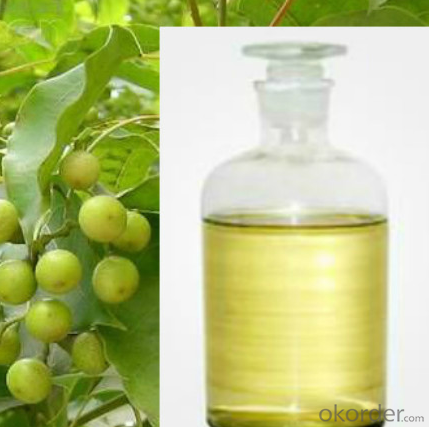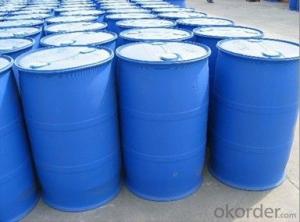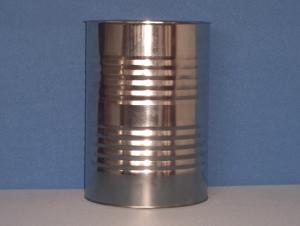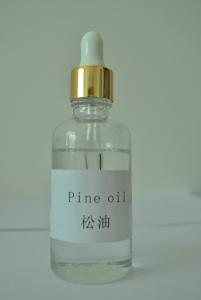Pine Oil with Factory Directly Sell and Competitive Price and High Quality
- Loading Port:
- Shanghai
- Payment Terms:
- TT or LC
- Min Order Qty:
- 17.6
- Supply Capability:
- 3000 m.t./month
OKorder Service Pledge
OKorder Financial Service
You Might Also Like
1. Structure of Pine Oil Description:
CAS NO.: 8002-09-3
MF: C10H17OH
PURITY:
Purity: 45% 50% 70% 80%
Packing&Delievery: 170kg/iron drum (Capacity of per 20'FCL: 80 drums,totally 13.6mt per container)
All year Delievery
2. Main Features of Pine Oil:
The pine oil is widely used in the flotation of various metallic and non-metallic minerals. It is mainly used in the flotation of various sulfide ores,such as lead,copper,zinc,and iron sulfide,and non-sulfide minerals. It exhibits some collecting properties,especially for readily floatable minerals such as talc,graphite,sulphur,molybdenite and coal etc.
3.Pine Oil Images



4.Pine Oil Specification
Item | 50% | 65% | 70% | 85% |
Appearance | Slight-yellowish or brown-yellowish oil-shape liquid. | |||
Color and state( Max). | 6 | 6 | 6 | 6 |
Content of water (Max). | 0.7 | 0.7 | 0.7 | 0.7 |
Total acid value (Min) | 50 | 65 | 70 | 85 |
Gravity | 0.866 | 0.90-0.92 | 0.90-0.92 | 0.92-0.94 |
Distillation range(°C) | 168-230°C | 170-225°C | 170-225°C | 190-225°C |
Impurities(MAX) | 0.5% | 0.5% | 0.5% | 0.5% |
PH value | 5-7 | 5-7 | 5-7 | 5-7 |
Impurity( Max). | 0.5 | 0.5 | 0.3 | 0.3 |
5.FAQ
1)Q:Are you a factory or trading company?
A:We are a factory.
2)Q:What is thepayment terms?
A: L/C ,T/T, D/P, W/U
3)Q:How can I get some samples?
A: Kindly send us your address, we are honored to offer you samples.
4)Q:How does your factory do regarding quality control?
A: Our factory can accept any third party inspection.
- Q: anybody here knows the difference of organic iron salt (ex. F.gluconate) vs inorganic (ex. F.sulfate)?
- It it's organic, then the anion (the negative ion) is the conjugate base of an organic acid. If it's inorganic, then the original acid was inorganic (like H2SO4 making sulphates).
- Q: Urine in the inorganic salt content is higher than the original urine
- In fact, the concentration has increased
- Q: Are there any differences between minerals and inorganic salts?
- There are differences, some minerals exist in organic matter, and some minerals are inorganic salts. Inorganic salts are inorganic.
- Q: Chemical formula The longest inorganic salt
- The longest can have a large number of atoms, I remember the teacher said is more than a hundred different atoms or groups
- Q: What is the most important inorganic salt in plant growth?
- The inorganic salts required by plants are nitrogen, phosphorus and potassium containing inorganic salts, and if any lack of plants will affect the normal growth of plants, nitrogen is a component of many important organic compounds in the body, such as protein, nucleic acid, chlorophyll , Enzymes, vitamins, alkaloids and some hormones contain nitrogen. Nitrogen is also the basis of genetic material in all organisms, the most important protein, it is often in the center of metabolic activity.Now is to limit the growth of plants and the formation of the primary Factor. It also has a significant effect on improving the quality of the product.K2 is dissolved in the plant juice, and its main function is related to the metabolism of the plant.The content of phosphorus in the plant is second only to nitrogen and potassium, Phosphorus plays an important role in plant nutrition. Almost all important organic compounds in plants contain phosphorus. Phosphorus is involved in photosynthesis, respiration, energy storage and delivery, cell division, cell enlargement and other processes in plants.
- Q: Cells in the water, inorganic salts, protein, lipid, carbohydrate and nucleic acid six words how wrong this sentence
- Divided into organic compounds and inorganic compounds are not two categories
- Q: What is the inorganic salt, is not the organic salt and is not the inorganic salt
- There is no concept of organic salt inorganic salt inorganic salts in the class of chanting
- Q: If you boil down salt to a vapor form and breathe it in, can it kill you? or do you have to mix it with another chemical for it to become deadly. (Or will the vapor be so hot it will burn your lungs)
- The boiling point of salt is incredibly high. Like thousands of degrees Celsius high. If you can actually manage to boil salt I would not recommend inhaling it.
- Q: The human body does not intake of minerals can be? Lack of minerals on the human body what kind of harm?
- Mineral is a naturally occurring compound or natural element in the crust, and minerals, like vitamins, are essential elements of the body, and minerals are not self-contained. Generated, synthetic, daily intake of minerals is basically determined, but with age, gender, physical condition, environment, working conditions and other factors are different.
- Q: Why are inorganic sodium salts much better soluble in ethanol than potassium salts?
- Sodium ions are smaller cations than potassium ions. Ethanol has a polar bond in the OH, but it also has a nonpolar tail, the ethyl group. So, unlike water, that has two OH groups that are polar and can interact with cations, ethanol has only one, so it requires strong electrostatic attractions to form a hydrogen bond - dipole interaction with any cation that it encounters. Being smaller, the sodium ions have their positive charge concentrated over a much smaller volume, so the polar OH bond in ethanol is more strongly attracted to the concentrated charge of the sodium than to the diffuse charge of the potassium ion, making the salt more soluble in this solvent.
Send your message to us
Pine Oil with Factory Directly Sell and Competitive Price and High Quality
- Loading Port:
- Shanghai
- Payment Terms:
- TT or LC
- Min Order Qty:
- 17.6
- Supply Capability:
- 3000 m.t./month
OKorder Service Pledge
OKorder Financial Service
Similar products
Hot products
Hot Searches


























